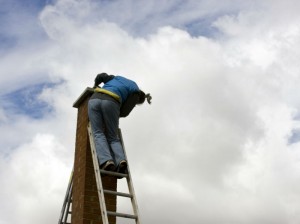
Watch out for the signs of chimney damage. Have it inspected and repaired right away!
Now that spring is headed our way, we can finally cut back on using your chimney. This is also the time you need to start thinking about maintenance. You should have at least one chimney sweep and inspection done every year. You can find the right technician by not only reading reviews and trusting in your family and friends, but also making sure that they are Chimney Safety Institute of America (CSIA) certified. To schedule your chimney appointment, call the pros at Jack Pixley Sweeps.
What kind of repairs will need to be done to your chimney?
Even the smallest crack can turn into the biggest hassle if not dealt with. This is why if you see something out of the ordinary that you call for a checkup. If you live in an area where high precipitation is common, then any crack you have in the structure could hold this water and allow mold to grow. This can happen in as little as two days, and the mold can spread to the foundation of your home and you air supply.
Water can also enter the chimney when the flashing is damaged. Sometimes the flashing can be repaired, but often it will just need replacing. Lastly, a chimney cap will keep water from running down inside of the chimney and causing liner and other internal damage.
After these repairs are finished, your technician may suggest waterproofing your chimney. This is a simple process in which a sealant is sprayed on the chimney to help prevent water damage. You should always make sure you are sealing a dry, clean chimney.
What happens when these repairs are not taken care of?
When repairs are left for long periods of time without care, they can worsen. Cracks will begin to expand and will be able to collect more water after more storms and high winds. Also, if you do not have your chimney sweep on time, blockages can become larger and more dangerous. This could lead to a higher chance of chimney fire. Blockages will cause draft problems as well, which could keep harmful gases like carbon monoxide in.

Chimney care should be a must on your to-do list for Spring. It deserves to be given proper attention after enduring the cold winter days while keeping you warm.
Spring. It’s the time of the year where you can free yourself from months of wearing thick clothes and triple socks. It’s the perfect time to finally go outside and play without having to worry about freezing to death. It’s also the time where your chimney can finally rest and prepare for the next time of extensive usage. But it doesn’t mean that you’ll just tuck away your chimney until the next winter. No, there are still some things to take care of because of the shift in temperature.
Chimney Inspection and Sweeping
Here at Jack Pixley Sweeps & Masonry we’d like to present a Spring checklist so that when one of our certified CSIA chimney sweeps knock on your door, you already know what to expect. The very first and very basic things to do are the routine inspection and sweeping. From there they can assess whether or not your chimney needs any of the following:
Waterproofing
As winter comes to an end, there will be a lot of traces of melting snow. This is bad for the chimney because huge volumes of water can destroy the chimney. The chimney will start to degrade overtime and water can enter the small cracks and joints of the masonry brick walls that will further speed up the degradation of the chimney. When this happens, there might be a need for waterproofing. When we’re done, even the smallest ant cannot find cracks to live in inside your chimney. Another good way to keep water out is to install chimney flashing. This will block water from coming in where the exterior of the chimney meets the roof.
Chimney Relining
Again, as the chimney gets old, damage to the the flue and the flue liner will be inevitable. This problem should be addressed right away because it leads to poor chimney draft. If there are holes in the flue, there won’t be enough pressure to push up all the smoke to the chimney and you’ll have a smoky fireplace. If the flue liner is the problem, chimney relining will solve it. Otherwise, if the damage is to the structure of the flue itself, we might have to go as far as replacing the whole thing.
Install a Chimney Cap
Since we’re talking about spring, there are now bigger opportunities for debris, leaves and other obstructions (including tiny animals looking for a home) to enter the chimney. Having a chimney cap installed will totally stop these things from entering the inside of the chimney.
These are a few of the things that we can to do ensure that your chimney will last for many years to come. And not only that, when you invest in maintaining your chimney, you won’t have to worry about accidents due to functional problems while using your chimney. You’ll also end up saving money in the long run by avoiding these untoward incidents that might cause severe damage to your property. Make an appointment with us now. Jack Pixley Chimney Sweeps & Masonry: “It’s the name you can trust.”
If your home has a chimney, you’ll have to have it cleaned sooner or later; it’s recommended that you have it done yearly at the very least. The National Fire Protection Association (NFPA) and Chimney Safety Institute of America (CSIA) classify chimney inspections into three categories: Level 1, Level 2, or Level 3. Each level of inspection covers specific items depending on the equipment and how it is vented to the outside of your home. Taking an in-depth look at all three levels will give you a clearer understanding of what’s completed during each and how each subsequent level builds on the work completed during the previous level(s).

Having your chimney inspected and cleaned annually helps minimize any safety risks and maximizes performance.
Levels of Inspection
1.Level 1 – these are completed during a routine chimney cleaning and, as such, should be carried out annually. This more routine level of evaluation is the recommended course of action when the conditions of use have not changed over the past year. These inspections are limited in scope to the portions of the chimney’s exterior and interior that are easily accessible as well as the portions of the fireplace and flue that are readily accessible. The technician will look to gauge the condition of the flue and chimney structure as well as your basic fireplace installation and connections. The technician will also check to make sure that the chimney is free of obstructions and combustible deposits.
2.Level 2 – these are more detailed and thorough than the previous level and are recommended either when the conditions of use have changed during the past year or when a Level 1 inspection revealed an issue that warrants a more thorough inspection. A few notable issues that may call for a more in-depth inspection are homeowners opting to convert their traditional fireplace to a gas unit or when an event has occurred that could have compromised the chimney in some way (e.g., chimney fire, earthquake, or foundation settling). It’s also recommended upon the sale or transfer of the property. These inspections include everything a Level 1 inspection would include as well as the inspection of accessible areas of the attic, basement, and crawlspace and a video evaluation of the inside of your chimney.
3.Level 3 – these are the most in-depth of all the inspection types and are conducted after either a Level 1 or Level 2 inspection has revealed a major issue in parts of the chimney and/or flue that are not easily accessible. These inspections include all of the areas covered in Level 1 and Level 2 inspections as well as inspection of otherwise concealed areas to further investigate known or suspected problems. Because certain portions of Level 3 inspections require some sort of demolition to, within, or around your home, the technician will discuss this work with you prior to beginning anything.
That’s a lot of information to pack into one blog. The information is, however, extremely important. Understanding the general scope of work required with each level of inspection is critical to being an informed homeowner and consumer. We want all of our customers to be pleased with the work we do and not to be blindsided by the costs that go along with it. We wish you a happy and safe holiday season.



